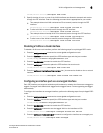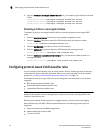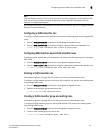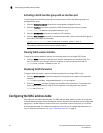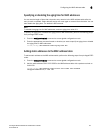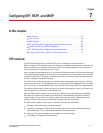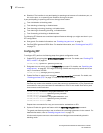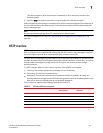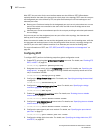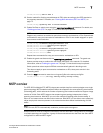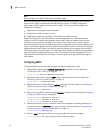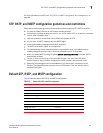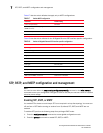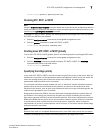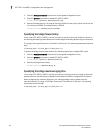
Converged Enhanced Ethernet Administrator’s Guide 59
53-1002163-02
RSTP overview
7
DRAFT: BROCADE CONFIDENTIAL
This does not apply to ports connected to workstations or PCs; these ports remain in the
forwarding state.
5. Enter the copy command to save the running-config file to the startup-config file.
When the spanning tree topology is completed, the network switches send and receive data only on
the ports that are part of the spanning tree. Ports that receive superior BPDUs are automatically
place in blocking mode.
NOTE
Brocade recommends leaving other STP variables at their default values.
For more information on STP, see “STP, RSTP, and MSTP configuration and management” on
page 64.
RSTP overview
NOTE
RSTP is designed to be compatible and interoperate with STP. However, the advantages of the RSTP
fast reconvergence are lost when it interoperates with switches running STP.
The IEEE 802.1w Rapid Spanning Tree Protocol (RSTP) standard is an evolution of the 802.1D STP
standard. It provides rapid reconvergence following the failure of a switch, a switch port, or a LAN. It
provides rapid reconvergence of edge ports, new root ports, and ports connected through
point-to-point links.
The RSTP interface states for every Layer 2 interface running RSTP are as follows:
• Learning—The interface prepares to participate in frame forwarding.
• Forwarding—The interface forwards frames.
• Discarding—The interface discards frames. Note that the 802.1D disabled, blocking, and
listening states are merged into the RSTP discarding state. Ports in the discarding state do not
take part in the active topology and do not learn MAC addresses.
Table 15 lists the interface state changes between STP and RSTP.
TABLE 15 STP versus RSTP state comparison
STP interface state RSTP interface state Is the interface included in the
active topology?
Is the interface learning MAC
addresses?
Disabled Discarding No No
Blocking Discarding No No
Listening Discarding Yes No
Learning Learning Yes Yes
Forwarding Forwarding Yes Yes



